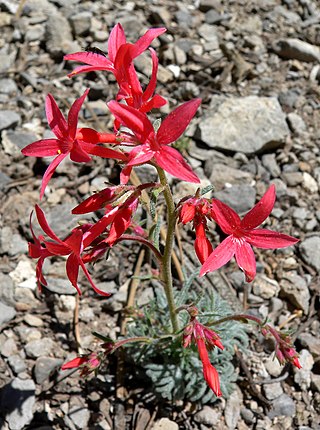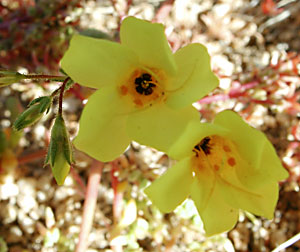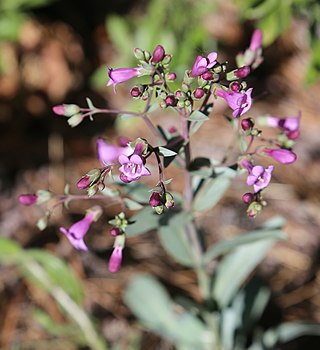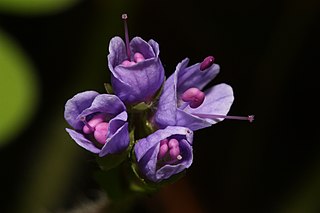
Ipomopsis arizonica is a flowering plant in the family Polemoniaceae, native to the mountains of the Mojave Desert sky islands from southeastern California east through southern Nevada to northern Arizona, growing at 1500–3100 meters in elevation. It is found in rocky places in the desert, as well as washes.

Phacelia crenulata is a species of flowering plant in the borage family, Boraginaceae. Its common names include notch-leaf scorpion-weed, notch-leaved phacelia, cleftleaf wildheliotrope, and heliotrope phacelia. Phacelia crenulata has an antitropical distribution, a type of disjunct distribution where a species exists at comparable latitudes on opposite sides of the equator, but not at the tropics. In North America, it is native to the southwestern United States as far east as Colorado and New Mexico, and Baja California and Sonora in Mexico. In South America, it is native to southern Peru, western Bolivia, and northern Chile.

Phacelia fremontii is a flowering plant in the family Boraginaceae native to the southwestern United States. In California, its range includes the Mojave Desert, the San Joaquin Valley, the Coast Ranges, and the Sierra Nevada. It was named for John C. Frémont.

Eriastrum pluriflorum is a species of flowering plant in the phlox family known by the common names Tehachapi woollystar and many-flowered eriastrum.

Gentianopsis holopetala is a species of flowering plant in the gentian family known by the common names Sierra fringed gentian or just "Sierra gentian"'. It is native to the Sierra Nevada and adjacent mountains in California and Nevada, in wet meadows from 6000 to 11,000 ft in elevation. This is an annual or perennial herb, growing stems which may be anywhere from a few centimeters long to nearly half a meter, and may lay along the ground or grow erect. Its small oval or spoon-shaped leaves are mostly basal but may grow sparsely further along the stem.

Gilia brecciarum is an annual flowering plant in the phlox family (Polemoniaceae), known by the common name Nevada gilia or break gilia.

Abronia turbinata is a species of flowering plant in the four o'clock family known by the common name transmontane sand-verbena. It is native to eastern California and Oregon and western Nevada, where it grows in desert and plateau scrub.

Leptosiphon aureus is a species of flowering plant in the phlox family known by the common name golden linanthus.

Leptosiphon parviflorus is a species of flowering plant in the phlox family known by the common name variable linanthus.

Diplacus torreyi is a species of monkeyflower known by the common name Torrey's monkeyflower.

Muilla transmontana is a species of flowering plant known by the common name Inland muilla. It is native to sections of the Great Basin in Nevada and in California east of the major mountain ranges. It grows in mountain forest and scrubby high desert and plateau habitat.
Nemophila pulchella, known by the common name Eastwood's baby blue-eyes, is a species of flowering plant in the borage family. It is endemic to California, where it is found from the San Francisco Bay Area to the southern Sierra Nevada to the Transverse Ranges. It grows in many types of mountain, foothill, and valley habitats.

Penstemon patens is a species of penstemon known by the common name Lone Pine beardtongue. It is native to the central Sierra Nevada of California and slopes and plateau to the east, its distribution extending just into Nevada. It grows in forest, woodland, and scrub habitat types. It is a perennial herb producing hairless, waxy stems up to about 40 centimeters tall. The thick, lance-shaped, gray-green, opposite leaves are up to 9 centimeters long and 2 wide. There are usually many leaves clustered around the base of the plant and smaller pairs higher on the stem. The inflorescence bears wide-mouthed tubular flowers up to 2 centimeters long with corollas in shades of lavender to magenta. The flower is mostly hairless except for the staminode which may have a coat of orange or yellowish hairs.

Phlox diffusa is a species of phlox known by the common name spreading phlox. It is native to western North America from British Columbia to the southwestern United States to the Dakotas, where it grows in many types of habitat, including rocky, high elevation mountain slopes. It is a very compact mat-forming perennial herb growing in cushions or patches of short, decumbent stems. The linear, lance-shaped, or needle-like leaves are no more than 1.5 centimeters long and are oppositely arranged in bundles on the short stems. The inflorescence is a solitary tubular flower around a centimeter long. It has a flat white or pale pink or blue corolla with five lobes each just under a centimeter in length.
Ribes nevadense is a species of currant known by the common names Sierra currant and mountain pink currant.
Scrophularia atrata is an uncommon species of flowering plant in the figwort family known by the common names black-flowered figwort and darkflowered figwort. It is endemic to California, where it is known only from a section of the Central Coast Ranges in San Luis Obispo and Santa Barbara Counties. It grows in the calcareous and diatomaceous soils of the coastal canyons at elevations not exceeding 500 meters. There have been 44 observed occurrences of this species, but perhaps 25 of these are historic and may no longer exist. This plant is a perennial herb producing an erect, four-sided stem up to a meter tall or slightly taller. It is somewhat hairy to densely woolly in texture. The leaves have toothed oval blades up to 10 centimeters long which are borne on long petioles. The inflorescence is a wide-open panicle with several hairy, glandular branches bearing flowers. The flower has an urn-shaped corolla with a rounded body and an open mouth at the top which is edged with hoodlike lobes. The corolla is deep, dark red to nearly black in color. The fruit is a capsule just under a centimeter long containing many seeds.

Scrophularia lanceolata is a species of flowering plant in the figwort family known by the common names lanceleaf figwort and American figwort. It is native to North America, where it is known from western and eastern Canada and much of the United States except for the southeastern quadrant. Past common names include Western figwort when the western US plants were grouped under the name Scrophularia occidentalis and the eastern US plants were called Scrophularia leporella with the common name hare figwort.

Veronica regina-nivalis is a species of flowering plant in the figwort family known by the common name snowqueen, or snow queen. It is native to the Pacific coast of the United States from the Puget Sound to San Francisco Bay Area, where it grows in the forests of coastal and inland hills and mountains. It is a perennial herb growing up to about 15 centimeters tall. It has a rosette of basal leaves with hairy, lobed, heart-shaped or kidney-shaped blades borne on long petioles. The inflorescence is a small raceme of pale blue, lavender, or nearly white flowers each just under a centimeter long. The corollas are bell-shaped, the tube spreading into short lobes at the mouth, with two stamens tipped with large anthers.

Verbascum speciosum is a species of flowering plant in the figwort family known by the common name Hungarian mullein or showy mullein. It is native to eastern Europe and western Asia, and it is known in many other regions as an introduced species and roadside weed. It is a biennial herb forming a rosette of large leaves and an erect stem well exceeding one meter in maximum height. The leaves are 30 to 40 centimeters long and have smooth edges and pointed tips. The plant blooms in a large panicle with many branches lined with flowers. Each flower has a corolla measuring 2 to 3 centimeters wide with five yellow petals. There are five stamens coated in long white hairs at the center. The fruit is a capsule up to 7 millimeters in length containing many seeds.
Gilia yorkii is a rare species of flowering plant in the phlox family known by the common names Boyden Cave gilia and monarch gilia. It is endemic to Fresno County, California, where it is known from only one location in the southern Sierra Nevada. This plant grows in rock cracks in the limestone cliffs and outcrops in the chaparral and woodlands of the canyon.
















